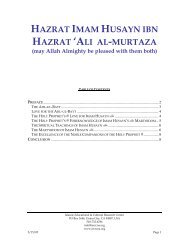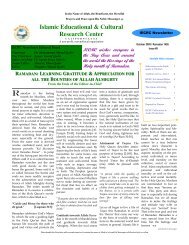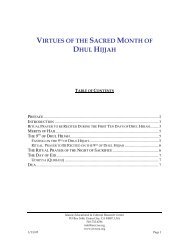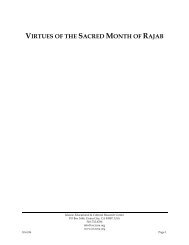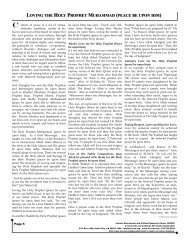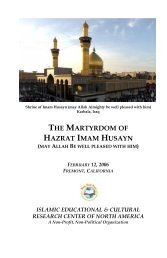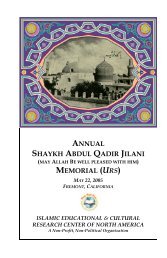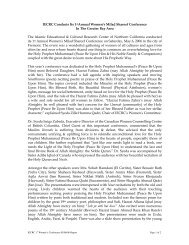Khwaja Ghareeb Nawaz rahmatullah alayh - IECRC
Khwaja Ghareeb Nawaz rahmatullah alayh - IECRC
Khwaja Ghareeb Nawaz rahmatullah alayh - IECRC
You also want an ePaper? Increase the reach of your titles
YUMPU automatically turns print PDFs into web optimized ePapers that Google loves.
MUSIC<br />
IN ISLAM<br />
<br />
Introduction<br />
The great Persian scholar Shaykh Abu Hamid Al-Ghazzali (1058 – 1111 CE,<br />
may Allah have mercy on him) writes in his magnum opus Ihya Uloom ud-Din,<br />
that “the human being has five organs and the intellect, and every organ has<br />
got a natural attribute of the sensation of the taste of joy. The natural attribute<br />
of the eye is to see. It enjoys the sight of beautiful things, such as various kinds<br />
of leaves and plants, a flowing stream, a beautiful face. In one word, all beautiful<br />
colors and sceneries are dear to the eye. Sight of an ugly color is displeasing<br />
to the eye. The nose has been created to smell. It loves sweet scents and fragrances<br />
and dislikes bad smells and the stench of rotten things. Take the case of<br />
the tongue. It likes sweet and greasy things and dislikes bitter and distasteful<br />
foods. Hands like smooth things more than hard and uneven things. Take the<br />
case of the intellect. It feels comfort in knowledge and dislikes illiteracy and<br />
ignorance. Similar is the case of the ear. The sound which the ears hear is of two<br />
kinds: sweet sounds like the sound of the nightingale and sweet songs, and<br />
displeasing sounds like the sound of the donkey. What is true of other organs is<br />
true also of the ears.”<br />
Music is therefore the name of sounds with melody, rhythm, tune, sweetness<br />
which may or may not have meaning for the human being. Sounds can be without<br />
rhythm as well which may still be pleasing such as someone talking in a<br />
calm manner. Sounds however can be displeasing as well as mentioned above<br />
such as the braying of a donkey. Sounds may be produced by nature such as<br />
the rustling of leaves, waves on the ocean or by birds, or by the human voice.<br />
This brief exposition is concerned with the melodious sounds of the human<br />
being and some musical instruments that carry meaning in the religious context.<br />
Samaa - Its Origins and History<br />
Most (Arab music in the pre-Islamic period) was used for dancing and marching,<br />
accompanied by drums and flutes. It caused emotion and made the serious<br />
--minded feel light. The Arabs continued this way during their desert and pre-<br />
Islamic period. Then, Islam made its appearance. The thriving religion (of Islam)<br />
and (Muslim) religious severity was directed against all activities of leisure<br />
and all the things that were of no utility in one's religion or livelihood.<br />
Therefore, (music) was avoided to some degree. In their opinion, only the cadenced<br />
recitation of the Qur'an and the humming of poetry which had always<br />
been their way and custom, were pleasurable things. (Khaldun)<br />
Page 11



